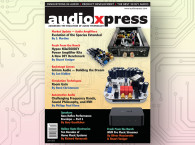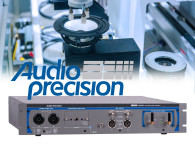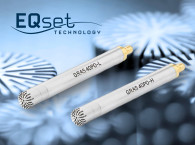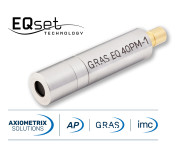
Rens Tellers: Rémi, thank you so much for taking the time to talk to us! I am familiar with GRAS microphone products; my latest acquisition was a wideband 140kHz mic for specialized acoustic measurements. So, when I saw the announcement for the new EQset series I was intrigued. Can you tell us what use these microphones are targeted at?
Rémi Guastavino: My pleasure! This microphone was designed to be used on production lines. So, this means from small audio devices upwards; mobile phones/microspeakers/tablet/headphones. For improved accuracy when measuring smaller devices (speakers and microphones), it is good practice to integrate your sound sensor in a receptive area of similar size as the object to be measured, and close-mic the measurement. This microphone contains a small optimized acoustic sound port to match the small devices being tested. The other important parameters are ease of use, cost effectiveness, no calibration required, and environmentally friendly. These are not necessarily needed for lab environments but make this microphone very usable in demanding environments!

To give you some more background, measurement microphones have a big spread in frequency response and sensitivity. Production microphones are an order of magnitude cheaper than measurement microphones. The main limitation is the capsule, which should be low cost. But note that environmental stability is also a real issue since the sensitivity of production microphones is varying roughly ±1dB due to variations in humidity and temperature. That’s when I got the idea of using a new cartridge design that is not affected by environmental factors, with internal digital adjustment and sent them out fully calibrated.
So that lead to the project’s main targets: reduce spread in specifications compared to more traditional microphones; powered either by phantom or CCP [constant current power] supply and, preferably manufactured in Denmark!
Tellers: Did you consider a digitally connected microphone? USB-connected microphones for measurement are found more and more it seems.
Guastavino: That’s a very good point and my first design ideas did consider that! However, market research showed that GRAS’ potential customers (mostly based in the measurement industry) wanted analog microphones with the same dimensions as their existing traditional microphones. This would facilitate the quick and direct replacement of microphones within existing production lines.
So that ruled out a USB microphone. But there is also one positive side to this. Consider clock jitter; since the same internal mic’s clock is used for AD as well as DA conversion and the digital domain is separated from the measurement equipment, there is no additional jitter introduced by different clocks, which could happen as soon as you start connecting multiple USB microphones with individually slightly different clocks to the same computer.

Tellers: Can we take a closer look into the microphone details? How is the calibration of each individual microphone carried out?
Guastavino: Sure. I will have to omit some details, which are company confidential, but the basics are as follows. Usually, measurement microphones are calibrated with an electrostatically calibration standard, but that’s not possible with the EQset due to the sound port design protecting the sensing element on this microphone.
A custom test box is used for the calibration process, consisting of a special speaker and reference microphone (Figure 1). The calibration process for the microphone-under-test is comparing it to a GRAS ¼” pressure measurement microphone (Patent Pending). The setup is connected to an Audio Precision analyzer after which a company-designed comparison method is used to tighten the microphones tolerances to a minimum.

A programming interface is connected to the microphone to apply the compensation, The settings and calibration are made by GRAS in their own labs and it’s not possible or necessary for users to do their own calibrations.
Tellers: So, in short, the calibration is using a kind of in-house Golden Standard.
Guastavino: Yes, the calibration flow is as follows. The test starts with a 30-second stabilization time after power on after which a first measurement is carried out. Compensation based upon the measurement is calculated and applied to the microphones internal to match the desired frequency response and the gain. Before finally boxing the product, a verification is done to ensure that all corrections were applied correctly.
So, with all of this in mind it was time to rethink the design. That got us to the following setup, a new pressure microphone called EQ 40PM with the following specs:
- A 20Hz to 20kHz pressure microphone with a dynamic range from 30 to 120dB (A);
- A new capsule design for environmental stability
- Internal A-D and D-A conversion
- Factory frequency response compensation
- Factory gain adjustment compensation
- Both phantom as well as CCP powered preamps are supported
- Staying within current production microphone price ranges
Inclusion of all these techniques in the traditional dimensions of 34mm × 7mm requires some extensive engineering skills, but we managed to squeeze all of it in this little pressure-based microphone!
But, to be honest, using a digital domain inside a microphone also causes some limitations. SPLmax is a bit lower and SPLmin a bit higher than what we are used to in a traditional microphone. The DA converter determines the dynamic range to about 90dB, which can be placed where it is most useful. Considering our customers’ demands, we set the range at 30dB to 120dB, which indeed covers most of the normal measurement conditions.
Tellers: You also mentioned a novel pressure sensing element. Can you give some more details here?
Guastavino: The new sensing element (capsule) is designed to be more stable towards humidity and temperature. Therefore, this gives a major advantage in environmental terms over traditional capsules, while remaining in a friendly price range. So, separately from the DSP use, GRAS also managed to improve environmental stability.
So, let’s show some data here. Figure 2 shows a comparison between a traditional and the new EQ 40M in terms of temperature stability; I believe the graph speaks for itself! With regard to humidity sensitivity, it’s even worse; including hysteresis, it can take days for a production microphone to go back to the original sensitivity!
It’s all published in the EQ 40M datasheet, of course. One spec you won’t find is for the AD and DA process; that is internal and transparent to the user.

Tellers: One other thing not so often seen in the datasheets is the microphone’s phase response. Are you publishing that?
Guastavino: Good point! GRAS evaluated the phase response and concluded it’s extremely consistent. The additional phase induced by the DSP is constant and thus similar to the phase shift you’ll get by slightly changing the microphone position. So, no correction is made to the phase response since it doesn’t seem to be a necessity. But, as with all microphones, the devil is in the positioning!
Tellers: You designed this product in close coordination with customer requirements. How do you make sure those requirements are known and taken into account?
Guastavino: That’s an important issue for us and has been from the beginning. To start, GRAS has a customization program: if customers want to have something that is not in the standard catalog, we will evaluate such requirements and come up with a suitable solution. It’s in our DNA.
An important part of this is GRAS actively going out to customers and taking part in the customers’ processes. We have an internal customization committee which will look over it and decide whether new ideas and/or projects are feasible within the current portfolio or should be considered for future product development. And it is actually a two-way street as exemplified by this new product offering. A lot of the input for this microphone’s technique came from the customers, not only the used techniques but also priorities (like what’s more important frequency or dynamical range or USB). Based upon the customers’ feedback, GRAS changed the product to contain an analog output instead of the USB connection initially intended. Customers really appreciate being part of the design process and seeing this new product being aligned to their wishes.
As a side note, let me mention that during the recent lock downs we really missed not always being able to go out to the customers and get all their internal notes, not only during meetings, but also the important discussions after the meeting at the coffee machines…
Tellers: What sort of customers do you serve?
Guastavino: GRAS’ customers can be found in all the various fields of product measurements. On the high side of the segment, you’ll find customers with their own test equipment — high-end brands which use high-end test equipment including high-end miking and using conditioned spaces for testing. One the lower side of the segment you’ll find production lines where simple sound cards are used requiring quick measurements results. And at the bottom of the segment, there is also a group which doesn’t test because it is simply too expensive for the product (think of cheap earbuds for 10 euros at the airport).
Tellers: Since this microphone is priced in the lower measurement microphone price range, one could expect more of the mid- and lower segment users to jump on-board with this product. What help is available for less experienced users?
Guastavino: As a customer, you get the microphone with a stated sensitivity. There are no manuals to wrestle through, as the microphone can just be connected and used with no adjustments or TEDS calibration files.
Unpack, plug in, and use, that’s it. If you really need it, there’s a QR code on the package that takes you to our website, to the microphones landing page, containing all the product information, and general topics such as on/off-grid usage and free-field vs pressure usage. And we make it a point that these microphones do not need any calibration, not for the microphone, and not for the used cable. That said, it is probably a good idea to check your whole measurement chain once in a while.

Tellers: It seems to me that this is the first step toward a new series of intelligent microphones. So what is the future?
Guastavino: It is in the plans to evolve the same technology to higher performance measurement microphone products, aiming for higher frequency bandwidths. There are a few hurdles to take here. The biggest limitation of dynamic range is due to the DSP and DA conversion, which currently resides at about 90dB. Traditional production microphones can reach around 120-130dB. GRAS is working on extending this range.
Tellers: Maybe in a future release, you could add some user setup functions, like moving the dynamical range to a specific position? Or maybe compensation for the grid in front of the capsule?
Guastavino: This is an item for the future, as for the 20Hz to 20kHz range the ¼” grid is small enough to avoid influencing the frequency response within this range. aX
This article was originally published in audioXpress, July 2023
GRAS Sound & Vibration
www.grasacoustics.com
About Rémi Guastavino
Rémi is Director of Product Management at GRAS Sound & Vibration, cooperating closely with business development and has a technical background with a PhD in Acoustic Measurement Methodology. Born and raised in France, Rémi Guastavino relocated to Sweden to study at the Royal Institute of Technology (KTH) where he earned an MSc in Engineering Physics and his PhD in acoustics. Rémi then moved to Denmark where he focused on user-centric acoustic solutions working in both technical and strategical positions. He started his industrial career path at Bruel & Kjaer in 2008 after which he changed to GRAS Acoustics in 2020. As director of product management at GRAS Sound & Vibration, Rémi Guastavino defines the new product strategy, which industries their products should be aimed at, and how they can be improved to address the needs of the customer. He has focused on both the technical and user-related aspects of next-generation acoustic transducers.






